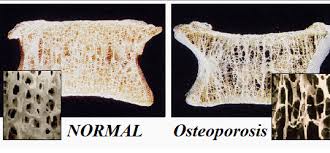Mens health Osteoporosis
Mens health Osteoporosis and Osteopenia are becoming significant issues. There are several reasons for this:
First, one of the reasons for an increase in Osteopenia and Osteoporosis among Men is because of an increased life span in the developed world. While death by age 50 was common a few decades ago, now it is usual for some men and women to live into their 70's and 80's.
Now our bone building is regulated by our sex hormones and so most
people reach their peak bone mass during their early to mid-thirties. Later as the amount of estrogen (women) or testosterone (men) begins to fade, we build less bone. At the same time, our osteoclasts (cells that remove old bone) continue working at the same pace as they always did. Result? We lose more bone that we build. And Osteopenia (thin bones) or Osteoporosis (porous bone) develops.
Now for women this shift usually occurs in their 40's as the amount of circulating estrogen drops. But for men, the shift occurs at a later age when the amount of circulating testosterone begins to drop.
Once this shift in our circulating sex hormones begins, we enter a stage of life where we lose more bone than we make. The longer we live, the longer this imbalance continues and the more bone we lose. So it is that the older men (and women) are likely to experience 'thinning bones' (Osteopenia) or openly porous bone. (Osteoporosis). Mens health Osteoporosis is likely to have a fracture when during a fall or when putting sudden stress on a bone.

It is common for men to experience bone
loss (Osteopenia or Osteoporosis) later in life than women. Women experience the shift in sex hormones much earlier than men.
B. Lunenfeld states in "Endrocrinology of the Aging Male" published in Minerva Ginecol. 2006 Apr;58(2):153-70:
"... men experience a slow and continuous decline (of sex hormones). This decline in endocrine function involves: a decrease of testosterone, dehydro epiandrosterone (DHEA), oestrogens, thyroid stimulating hormone (TSH), growth hormone (GH), IGF1, and melatonin. The decrease of sex hormones is concomitant with a temporary increase of luteinizing hormone (LH) and follicle-stimulating hormone (FSH). In addition sex hormone binding globulins (SHBG) increase with age resulting in further lowering the concentrations of free biologically active androgens.
Mens Health Osteoporosis: Younger men.
In 2006 an article was published "Study of Male Patients with Forearm Fracture in Northern Ireland". The study was done at Musgrave Park Hospital in Belfast and was published in Clinical Rheumatology.
The authors, Wright S, Beringer T, Taggart H, Keegan D, Kelly J, Whithead E, McKane R, McNally C, McQuilken M, Finch M.,found:
"... Male patients aged 30-75 years, presenting with distal forearm fracture in 2000-2001 in Northern Ireland, were identified through a Colles fracture database.
A total of 37 subjects consented to have bone mineral
density measurements undertaken at the femoral neck, spine and forearm. The results showed that 27% had osteoporosis at the spine, femoral neck or forearm.The cause? The researchers found that:
- 49% of
patients had vitamin D insufficiency or deficiency;
- 27% had low serum testosterone
- 14% had abnormal liver function test results, and
- 14% had
raised parathyroid hormone."
These are all known causes for excessive bone loss. And so this study not only revealed Mens Health Osteoporosis is possible but that it can come at a younger age than previously thought.
Read: Other Causes of Bone Loss (Osteoporosis, Osteopenia)
as well as the many Natural Treatments for Osteoporosis, Osteopenia

